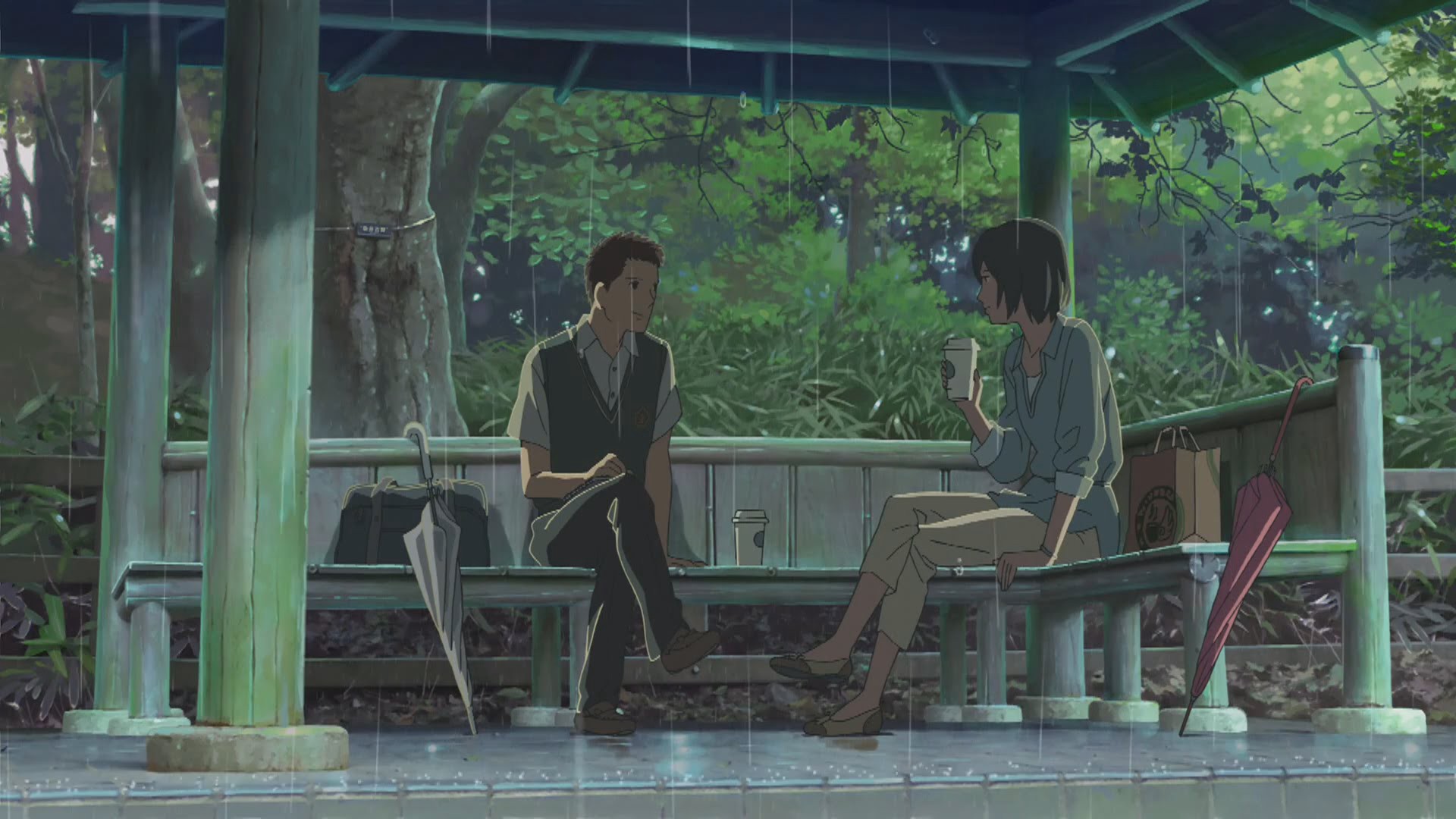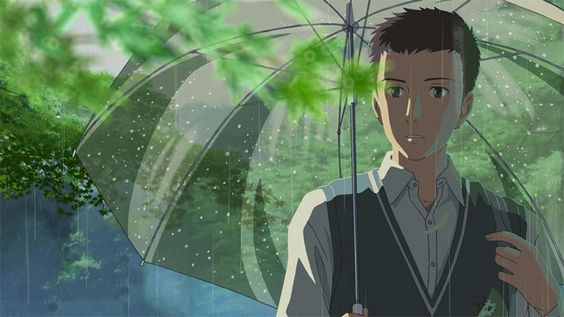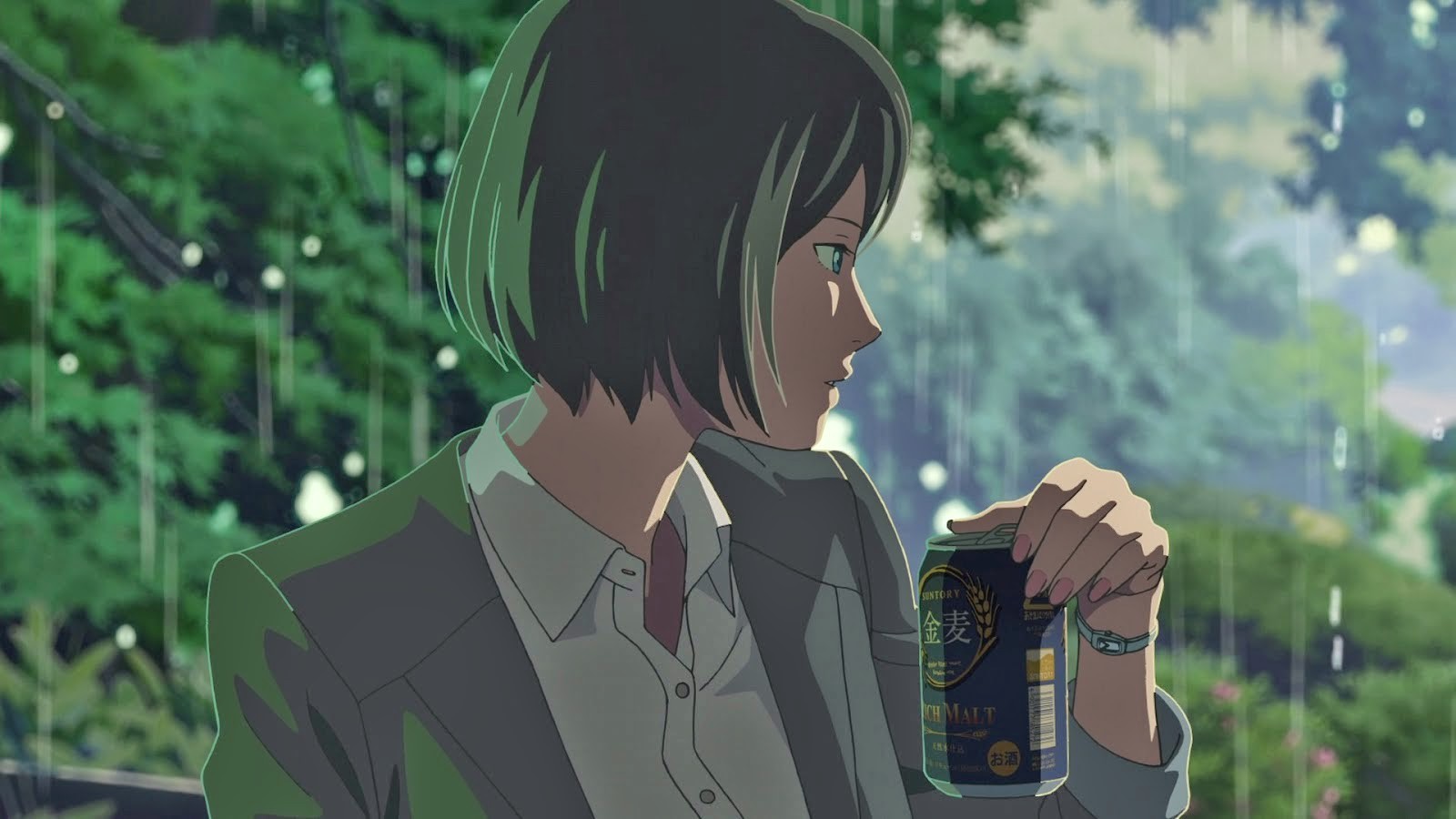
This is a loosely unstructured analysis of Makoto Shinkai?s The Garden of Words (2013, 46min), one of the best films I have ever seen. Originally posted on reddit. Text contains a Kimi no na wa spoiler.
I?ve watched all of Shinkai?s longer films, and nearly all of them have strong themes of distance and romanticizing the innocent eagerness of kids / the emotional rawness of teenagers, typically in contrast to adults which are often depicted as burdened by everyday life and no longer living the same rich emotional life as younger people.
I think The Garden of Words is groundbreaking as far as Shinkai?s work goes because it addresses distance in a socially controversial/unacceptable relationship between a student and a teacher. More broadly, I think this is groundbreaking for Japanese culture in general because of how social misfits are shamed strongly (stronger than in the West), while they comprise the main characters in The Garden of Words. Moreover, they are depicted realistically instead of heroic protagonists, with everyday psychological struggles and flawed human personalities ? this is the depiction of social misfits that is rare.
I also strongly admire the use of dialogue in The Garden of Words ? in my opinion the dialogue is remarkably minimal but more impactful than most films. Shinkai really makes each word count, whether its purpose is creating an atmosphere, telling a little backstory, a little friendly banter between family, etc. The minimal use of dialogue also makes it difficult to keep track of the character?s emotional states and how they feel about the other (student/teacher), which changes quickly ? since I?m not Japanese, it was difficult to pick up on honorific changes and notice common facial-expression cues. The first time I watched the final dramatic confrontation, I was rather surprised because it didn?t go how I would expect. After having rewatched it multiple times, and getting better at noticing the subtle social cues at play in Japanese culture, the final confrontation really does make sense, though what?s remarkable is that the characters still resonate as fully separate, fully conscious and feeling and thinking human individuals.
I feel like his presentation of the story between the two characters does not hand-hold the audience at all. Many stories rely on inner monologues and thought expositions to help the audience understand the inner thoughts of characters, but Shinkai shied away from that in The Garden of Words (though not in his other works), which is more challenging for the audience, but keeps more mystery in our personal understanding of the character. Overall this is much more similar to how we interact with people in real life, and to me this really fleshed out the characters in The Garden of Words as full human individuals despite the film only lasting 50 min with fairly sparse spoken dialogue.

The symbolism of the story addresses the human experience at a different angle than any of Shinkai?s other works. In my opinion, it addresses a facet of Japanese culture (though also broader human culture) that Japanese works in general do not typically address. The shoes are the most powerful imagery in the short film ? the student is an aspiring shoe-maker, and over the course of the film, he makes a pair of shoes for a woman who experiences physical anxiety when living a normal life in the public realm (working at her job ? going to a park instead of working is odd, bad, and not typical of what society expects you to do in public). In Asian culture you take your shoes off when entering a home, a private space. Shoes are clearly a tool used when individuals enter into a public space. More generally, homes are the space where family resides, or friends, or yourself if you are living alone, while the public space is where you interact with human society at large.
In the public space, especially in Japan, there are strong expectations to conform to ? use the right honorifics, be polite to strangers, have a job that helps society in general, not complaining about working overtime, etc. Society is a difficult beast and our individual relationship to society is complex and one of the most important relationships we have as a person. A common struggle throughout adolescence to adulthood is transitioning from largely receiving from society to being expected to give to society, captured in the $1m question ?What do I want to do with my life??, where ?not doing anything for society? is viewed as a bad answer. Within this framework, the story of The Garden of Words is about an adult who struggles with her relationship to the public space, to society in general. She meets a boy, a social outcast, at a time of mutual emotional need. At the ending, a gift of hand-crafted shoes represents healing in her relationship to the public space.
In the short post-credits scene, the boy says:
I was practicing how to walk, too. I believe that now. One day, when I can walk much further on my own, I will go see her.
Similarly to the lady, the boy doesn?t quite fit within society (though not as extreme as the lady). His life is no cakewalk either, and at the end his dialogue cements the interpretation that he was in need of healing, too.
Another interpretation of the entire theme about walking is, more straightforwardly, being able to walk through life.
A common theme in all of Makoto Shinkai?s works is exploring human connections (which he idealizes) created through abnormal means ? one extreme example is Kimi no na wa?s switching bodies. 5cm/s can also be viewed in this perspective, and in fact I imagine this is one angle that Shinkai used to come up with the story, by asking the question ?What if these two adults passing by each other at a train stop had a deep important human connection despite only having known each other in elementary school??, though Kimi no na wa can also be framed as ?What if you had a strong human connection to a person whose life you saved in an alternate reality? / What if it was a dream, but it really happened?? and I think it?s not too hard to frame the rest of his films this way too.
I think Shinkai explores abnormal human connections in The Garden of Words by asking the question, ?what if two people came to know each other strictly through private means, instead of starting in the public space?? It makes lots of sense through this question why both characters would be somewhat social misfits, and I think what cements this interpretation is the fact that neither of them knows each others? name or occupation (other than the boy?s obvious high school uniform) until the end, after seeing each other at the park for months. Name and occupation, clearly, being some of the first things you discover when you meet someone new, but they have it completely inversed ? the very first observations are of their private shameful pleasures (beer/chocolate during the day, sketching shoes).
I think I particularly like this story personally because I wish I could get to know someone deeply without having to play the public social game first. I crave late night talks about anything and everything, rather than the stifled set of appropriate conversation topics at meet-and-greets and mixers.

Shinkai?s theme of distance is portrayed by the final confrontation ? there are ideals on both sides, reality closes in, the lady rejects the exclamation of love by putting on her teacher ?hat? again (notably, by correcting the boy?s use of a lower honorific into a higher honorific). Another point that supports the private/public interpretation is that the boy responds by saying ?arigato gozaimashta?, which is the highest honorific form of ?thank you?, primarily used by restaurant owners to customers, or other similar financial transactions. It is jarring, bizarre to hear him use it, because it is only used between strangers, strangers interacting in public.
One could dream that getting to know someone through the private sphere first might enable a close relationship, a fantasy fulfilled, but through the rejection, Shinkai shows that there is still distance between the two characters. However, in the final part of the confrontation when the lady runs down the stairs and expresses her true emotions, Shinkai seems to suggest that this relationship was meaningful and worthwhile, despite humans being complicated. The takeaway is an ambiguous, somewhat hopeful ending which strikes a balance between the ambiguous, somewhat sad ending of 5cm/s and the overly happy ending of Kimi no na wa, which, while enjoyable, left me feeling a little too teenager-y.
And of course, The Garden of Words? art is absolutely incredible. The story?s slower pace means that The Garden of Words? art will probably still be easier enjoyed than Kimi no na wa?s art as well, though I guess we?ll have to wait for the 1080p version of Kimi no na wa to definitively say.
To sum up, I like The Garden of Words for its presentation (art, use of dialogue) and for tackling a story that few other filmmakers have attempted. I also like it because Shinkai breaks away from the same-old motifs he uses repeatedly in all his other films; The Garden of Words is certainly more experimental in its story than most of his other films.
